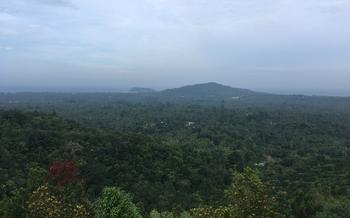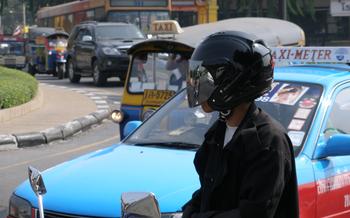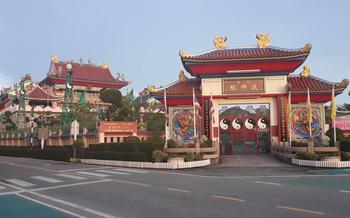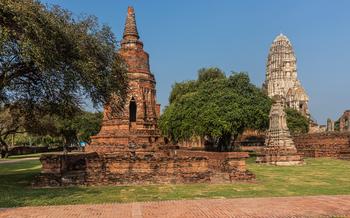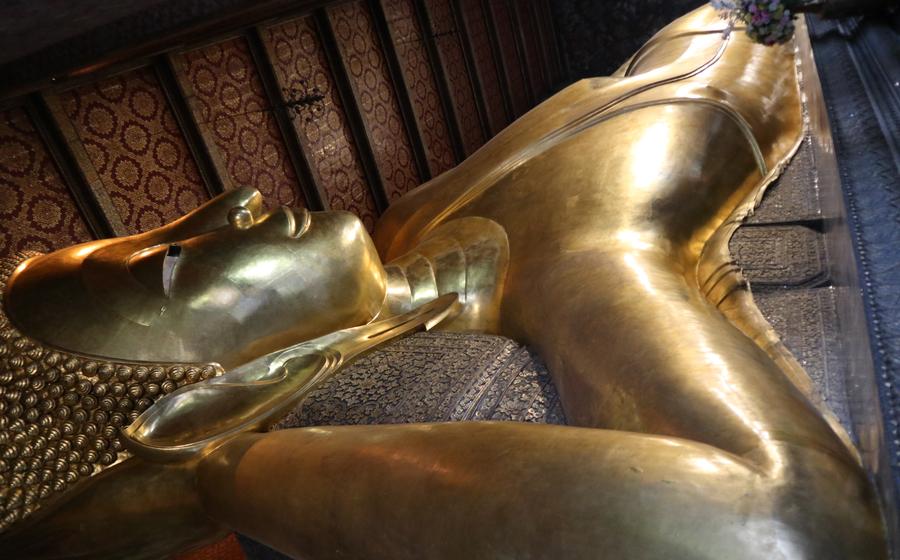
Wat Pho (Temple of the Reclining Buddha)
- History of the Temple
- Reclining Buddha (Phra Buddha Saiyas)
- Wat Pho Chedi:
- Phra Mondop
- Viharn of the Emerald Buddha
- Meditation and Spiritual Practices
- Museum and Exhibitions
- Architecture and Design
- Local Traditions and Ceremonies
- Photography and Videography
- Accessibility and Facilities
- Local Markets and Shops
- Dress Code and Etiquette
- Insider Tip: Unveiling the Hidden Gems of Wat Pho
History of the Temple
Wat Pho, also known as the Temple of the Reclining Buddha, is a majestic and sacred site that holds immense historical and cultural significance in Thailand. Its origins date back to the Ayutthaya Kingdom when King Rama I commissioned its construction in the late 18th century. The temple served as a royal monastery and a center for religious ceremonies and education.
Wat Pho's architectural style reflects a blend of traditional Thai and Khmer influences, showcasing intricate carvings, sculptures, and decorative elements. It is renowned for its colossal Reclining Buddha, measuring an impressive 46 meters in length and 15 meters in height. The reclining pose, symbolizing the Buddha's passing into Nirvana, exudes a sense of tranquility and serenity, drawing visitors from around the world.
Reclining Buddha (Phra Buddha Saiyas)
Wat Pho is renowned for housing the iconic Reclining Buddha (Phra Buddha Saiyas), a colossal statue that exudes both awe and serenity. Measuring an impressive 46 meters in length and 15 meters in height, this magnificent artwork is a testament to the artistry and devotion of the ancient craftsmen.
The reclining pose of the Buddha symbolizes the moment of his passing into Nirvana, the ultimate state of liberation from suffering and the cycle of rebirth. The statue's peaceful expression and intricate details, from the perfectly aligned fingers to the serene facial features, evoke a sense of tranquility and spiritual enlightenment.
The Buddha's body is covered in gold leaf, shimmering in the soft light of the temple interior. The soles of his feet are adorned with intricate mother-of-pearl inlays, depicting auspicious symbols and stories from the Buddha's life. These intricate details add to the statue's grandeur and make it a masterpiece of Buddhist art.
Wat Pho Chedi:
Wat Pho is renowned for its four massive chedi (stupas), each standing at an impressive height. These towering structures hold immense architectural significance and religious symbolism. The chedi represent the four elements: earth, water, fire, and air, symbolizing the balance and harmony of the universe. Their design reflects the influence of both Thai and Khmer architectural styles, blending elegance and grandeur.
The chedi are adorned with intricate carvings and sculptures depicting scenes from Buddhist mythology and cosmology. These intricate details showcase the exceptional craftsmanship and artistic prowess of the ancient artisans. Each chedi is crowned with a golden stupa, symbolizing the pinnacle of spiritual attainment and enlightenment.
Historically, the chedi have played a significant role in Buddhist ceremonies and rituals. They are believed to contain relics and sacred objects that are deeply revered by devotees. Offerings and prayers are made at the chedi, seeking blessings, protection, and spiritual guidance.
One notable chedi is the Phra Chedi Luang, which is the largest and most prominent of the four. It was constructed by King Rama I to commemorate his victory over the Burmese and to enshrine a relic of the Lord Buddha. The Phra Chedi Luang is a magnificent sight, showcasing the architectural splendor of Wat Pho and its enduring legacy as a sacred Buddhist site.
Phra Mondop
The Phra Mondop is an octagonal-shaped pavilion located within the Wat Pho complex. It serves as the central shrine of the temple and houses a highly revered Buddha image known as Phra Buddha Deva Patimakorn. The pavilion's octagonal design symbolizes the eightfold path of Buddhism, which represents the path to enlightenment and liberation from suffering.
The Phra Mondop is significant in Buddhist rituals and ceremonies, particularly during the annual Kathina ceremony, where monks gather to offer new robes to the Buddha image. The pavilion's central location and octagonal shape create a sacred space for meditation and spiritual reflection.
The architectural details and cultural symbolism of the Phra Mondop are noteworthy. The pavilion's roof features intricate carvings and colorful decorations, showcasing the artistry and craftsmanship of the Ayutthaya period. The eight sides of the pavilion represent the eight directions of the compass, symbolizing the Buddha's teachings reaching all corners of the world.
Visitors to Wat Pho are drawn to the Phra Mondop's serene atmosphere and the opportunity to pay homage to the revered Buddha image. The pavilion offers a glimpse into the rich cultural heritage of Thailand and the profound spiritual significance of Buddhism in Thai society.
Viharn of the Emerald Buddha
Before becoming the centerpiece of the Grand Palace, the sacred Emerald Buddha (Phra Kaew Morakot) temporarily resided in Wat Pho's Viharn of the Emerald Buddha. This ornate pavilion, also known as Phra Ubosot, served as a sanctuary for the revered Buddha image during the reign of King Rama I, who founded the Chakri dynasty in 178The Viharn, constructed in a blend of Thai and Khmer architectural styles, features intricate carvings, colorful murals, and a towering spire that dominates the temple complex.
Inside the Viharn, visitors can marvel at the Emerald Buddha, a small but highly revered statue carved from a single block of jade. This iconic Buddha image, considered the palladium of Thailand, holds immense religious and cultural significance for Thai people. The Viharn's interior is adorned with elaborate decorations, including gold leaf, lacquerwork, and exquisite murals depicting scenes from Thai history and mythology.
Whether you're a devout Buddhist or simply a curious traveler, a visit to the Viharn of the Emerald Buddha is a must. This sacred space offers a glimpse into Thailand's rich history, cultural heritage, and deep reverence for the Emerald Buddha, a symbol of national unity and prosperity.
Meditation and Spiritual Practices
Wat Pho, renowned for its cultural and spiritual significance, serves as a sanctuary for meditation and spiritual introspection. The temple's serene ambiance and peaceful atmosphere provide an ideal setting for visitors to deepen their connection with their inner selves. Guided meditation sessions, led by experienced practitioners, are offered to visitors, introducing them to various meditation techniques and promoting mental clarity and inner peace.
For those seeking a more profound spiritual experience, Wat Pho offers spiritual retreats and workshops. These immersive programs delve into the teachings of Buddhism, guiding participants through meditation practices, mindfulness techniques, and the exploration of Buddhist philosophy. Whether you're a seasoned meditator or a curious beginner, Wat Pho provides an opportunity for spiritual growth and self-discovery in the heart of Bangkok.
Museum and Exhibitions
Wat Pho's on-site museum, located within the temple grounds, is a treasure trove of artifacts, sculptures, and religious relics that offer a glimpse into Thailand's rich history, culture, and Buddhist traditions. The museum's interactive exhibits provide visitors with an immersive and educational experience, shedding light on the temple's significance and the development of Buddhism in Thailand.
Visitors can explore displays showcasing ancient Buddha images, intricate carvings, and religious objects used in ceremonies. The exhibits delve into the history of Wat Pho, its architectural evolution, and the role it played as a center for learning and religious practices.
The museum also features a collection of traditional Thai medicine and massage tools, highlighting the temple's renowned massage school and its contributions to the field of traditional Thai massage. Visitors can gain insights into the techniques, principles, and healing properties of Thai massage, which has become an integral part of Thai culture and healthcare.
Exploring the museum at Wat Pho is an enriching experience that complements a visit to the temple. It provides visitors with a deeper understanding of the temple's history, cultural significance, and the enduring legacy of Buddhism in Thailand.
Architecture and Design
Wat Pho's architectural grandeur is a testament to the artistry and craftsmanship of the Ayutthaya Kingdom. A fusion of traditional Thai and Khmer architectural styles, the temple complex showcases intricate details and decorative elements that captivate visitors. The soaring stupas, with their graceful spires reaching towards the sky, are a symbol of Buddhist enlightenment and aspiration. The viharns, or assembly halls, feature elaborate carvings, colorful murals, and intricate designs that tell stories from Buddhist mythology and history.
Within the temple grounds, visitors can marvel at the exquisite craftsmanship displayed in the numerous Buddha images, sculptures, and statues. The Reclining Buddha, with its colossal size and intricate details, is a masterpiece of Buddhist art. Its serene countenance and graceful posture exude a sense of tranquility and peace.
The Phra Mondop, an octagonal-shaped pavilion, is another architectural highlight. Its elegant design and intricate carvings symbolize the Eightfold Path of Buddhism. The pavilion houses a revered Buddha image known as Phra Buddha Deva Patimakorn, which attracts devotees from near and far.
Wat Pho's architecture seamlessly blends aesthetics and functionality. The temple's layout and design create a harmonious flow of movement, guiding visitors through the various sections of the complex. The use of natural elements, such as water features and lush gardens, enhances the serene atmosphere and provides a tranquil respite from the bustling city.
Local Traditions and Ceremonies
Wat Pho is not only a place of worship but also a center for cultural and religious events. Throughout the year, the temple hosts various festivals, ceremonies, and rituals that showcase the rich traditions and beliefs of Thai Buddhism.
One of the most significant festivals held at Wat Pho is the Songkran Festival, also known as the Water Festival, which takes place in April. During this festival, people celebrate the Thai New Year by throwing water at each other, symbolizing the washing away of bad luck and impurities.
Another important ceremony is the Kathin Ceremony, which occurs during October or November. This ceremony involves the offering of new robes to monks who have spent the rainy season in meditation and study. Devotees participate in a procession, carrying the robes to the temple, accompanied by music and dance performances.
Visitors to Wat Pho during these festivals and ceremonies have the opportunity to witness and even participate in these vibrant celebrations, gaining a deeper understanding of Thai culture and religious practices.
Photography and Videography
Wat Pho's stunning architecture, intricate carvings, and awe-inspiring Buddha images offer a feast for the eyes and a treasure trove of photographic opportunities. Capture the grandeur of the Reclining Buddha from various angles, showcasing its intricate details and serene expression. Explore the temple complex, snapping shots of the chedi, viharns, and Phra Mondop, each with its unique architectural features.
Remember to be respectful when taking photos, avoiding using flash photography near the Buddha images. Follow the guidelines displayed throughout the temple regarding photography and videography. To capture the best shots, visit during the golden hours of sunrise or sunset, when the temple's warm hues create a magical ambiance. Take your time, experiment with different perspectives, and create lasting memories of your visit to Wat Pho.
Accessibility and Facilities
Wat Pho is committed to providing an accessible and enjoyable experience for all visitors. The temple complex is wheelchair accessible, with ramps and elevators available to navigate the different levels. Accessible restrooms are also provided for the convenience of visitors with disabilities.
Throughout the temple, visitors will find seating areas and drinking water stations to rest and refresh themselves. The temple staff is friendly and accommodating, always ready to assist visitors with any questions or needs they may have. To make the most of your visit, it's recommended to wear comfortable shoes as you'll be doing a lot of walking.
To enhance your understanding of Wat Pho's rich history and significance, consider joining one of the free guided tours offered by the temple. These tours provide valuable insights into the temple's architecture, religious practices, and cultural traditions.
Local Markets and Shops
Wat Pho's vicinity teems with vibrant local markets and shops, offering a delightful opportunity to immerse yourself in Thai culture and pick up unique souvenirs. The bustling Tha Thien Market, located just across the street, is a treasure trove of local delicacies, handicrafts, and souvenirs. From aromatic street food stalls to stalls selling intricate handmade crafts, this market offers a sensory feast.
Stroll through the narrow lanes, where friendly vendors display their wares, and engage in the lively art of bargaining. Hone your negotiation skills and strike a good deal on souvenirs such as hand-painted silk scarves, ornate Buddha statues, or traditional Thai musical instruments.
Don't miss the chance to sample the delicious street food offerings, including mouthwatering grilled meats, fresh seafood, and tropical fruits. Indulge in the flavors and aromas of Thailand as you explore the market's culinary delights.
For a more upscale shopping experience, head to the nearby River City Bangkok, a stylish mall showcasing a curated collection of Thai handicrafts, antiques, and contemporary art. Here, you can find high-quality souvenirs, including exquisite jewelry, ceramics, and home décor items.
Whether you seek unique souvenirs, local delicacies, or simply a glimpse into the vibrant local culture, the markets and shops surrounding Wat Pho offer an unforgettable experience.
Dress Code and Etiquette
When visiting Wat Pho, it is essential to dress appropriately and observe proper etiquette to show respect for the sacred nature of the temple. Visitors should wear modest clothing that covers their shoulders and knees. Avoid wearing revealing or transparent clothing, as this is considered disrespectful in Thai culture. It is also important to remove your shoes before entering the temple buildings and carry them in a respectful manner. When approaching the Buddha images, it is customary to bow or wai (a Thai gesture of respect) as a sign of reverence. Be mindful of your behavior and avoid loud talking or disruptive actions that may disturb the peaceful atmosphere of the temple. By following these guidelines, you can ensure a respectful and enjoyable visit to Wat Pho.
Insider Tip: Unveiling the Hidden Gems of Wat Pho
Beyond the well-known attractions, Wat Pho holds hidden treasures waiting to be discovered. Venture off the beaten path and explore the tranquil courtyards, where you'll find serene Buddha images nestled amidst lush greenery. Seek out the lesser-known shrines dedicated to various deities, each with its unique story and significance. These hidden gems offer a deeper glimpse into the rich spiritual tapestry of Wat Pho.
To truly immerse yourself in the temple's tranquility, plan your visit during the early morning or late afternoon when the crowds have dissipated. The serene ambiance during these hours allows for a more contemplative and spiritual experience. Embrace the opportunity to sit in silent meditation, soak in the peaceful atmosphere, and let the temple's energy wash over you.
Take advantage of the free guided tours offered by the temple. These tours, led by knowledgeable guides, provide fascinating insights into the history, symbolism, and cultural significance of Wat Pho. Learn about the temple's architectural wonders, the stories behind the Buddha images, and the role of Wat Pho in Thai Buddhism. These tours are an excellent way to deepen your understanding and appreciation of this sacred site.
